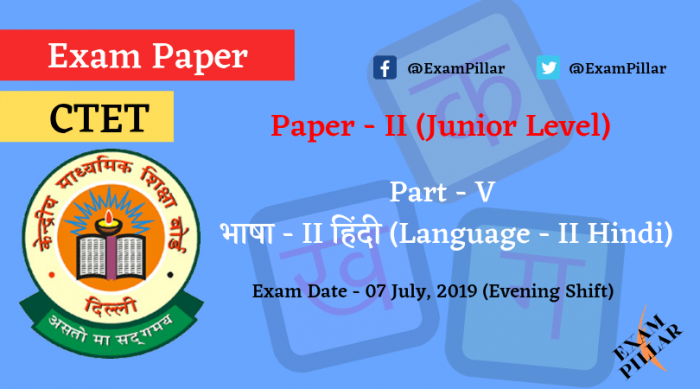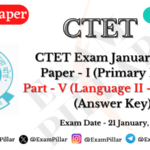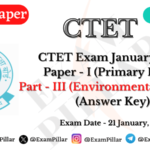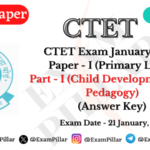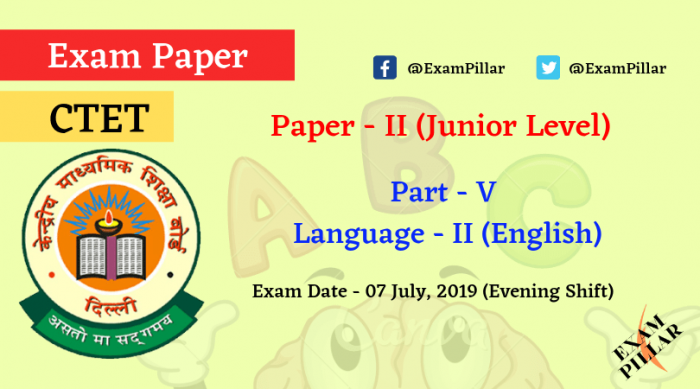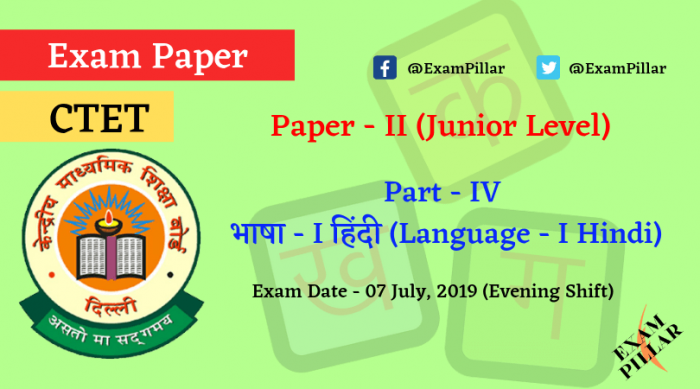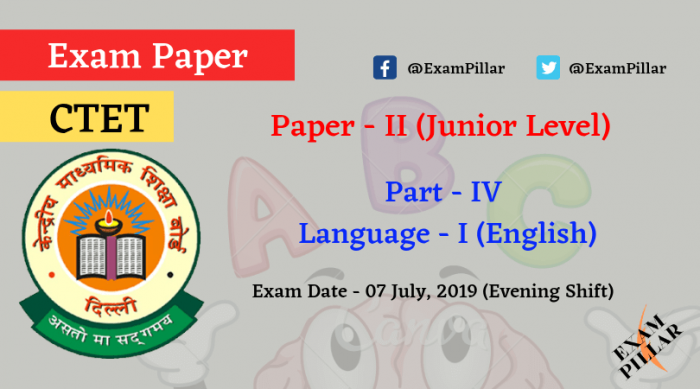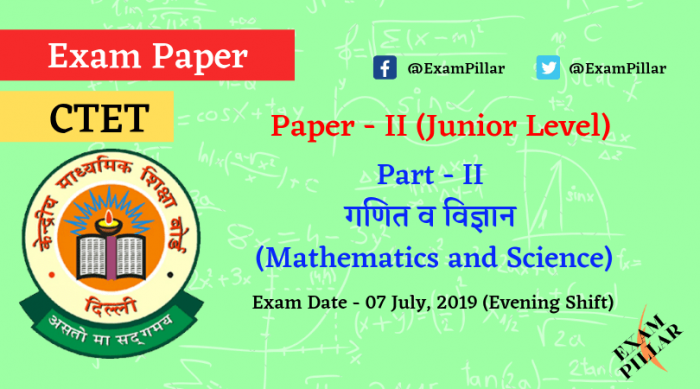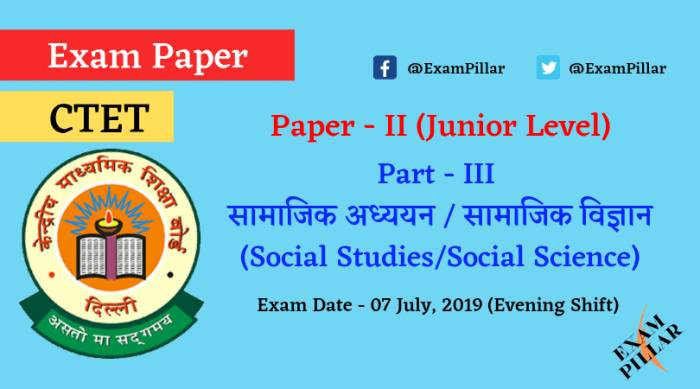CBSE conducted the CTET (Central Teacher Eligibility Test) Exam Paper held on 07th July 2019 Evening Shift. Here The CTET Paper – II Part – V Language – II (Hindi) Question Paper with Answer Key. CTET July 2019 Answer Key.
CTET (Central Teachers Eligibility Test)
Paper – II Junior Level (Class 6 to Class 8)
परीक्षा (Exam) – CTET Paper II Junior Level (Class VI to VIII)
भाग (Part) – Part – V भाषा – II हिन्दी (Language – II Hindi)
परीक्षा आयोजक (Organized) – CBSE
कुल प्रश्न (Number of Question) – 30
Paper Set – Y
परीक्षा तिथि (Exam Date) – 07th July 2019 (Evening Shift 02:00 PM – 04:30 PM)
Read Also …
- CTET 2019 Paper – II – Part – I – बाल विकास और शिक्षा-शास्त्र (हिंदी)
- CTET 2019 Paper – II – Part – I – Child Development and Pedagogy (English)
- CTET 2019 Paper – II – Part – II – गणित और विज्ञान (Mathematics and Science)
- CTET 2019 Paper – II – Part – III – सामाजिक अध्ययन / सामाजिक विज्ञान (Social Studies/Social Science)
- CTET 2019 Paper – II – Part – IV – Language – I (English)
- CTET 2019 Paper – II – Part – IV – Language – I हिंदी (Hindi)
- CTET 2019 Paper – II – Part – V – Language – II (English)
CTET Exam July 2019 Paper – 2 (Junior Level)
Part – V – भाषा – II हिन्दी (Language – II Hindi)
निम्नलिखित गद्यांश को पढ़कर पूछे गए प्रश्नों (प्र.सं. 121 से 128 तक) के सबसे उपयुक्त उत्तर वाले विकल्प चुनिए :
आज शिक्षा के क्षेत्र में भी बाज़ारीकरण हो जाने के कारण शिक्षा महँगी और गरीबों की पहुँच से बाहर हो चुकी है । एक ओर तो रुचि और उपयोगिता के अनुसार उपयुक्त शिक्षा पाने के लिए गरीबों के पास धन उपलब्ध नहीं है, तो वहीं जो संपन्न हैं उनके पास समय का अभाव है। ऐसे में ऑनलाइन शिक्षा व्यवस्था एक बेहतर विकल्प के तौर पर उभरी है । पिछले वर्ष देश के गरीब और स्कूल न जा सकने वाले बच्चों के लिए सरकार की ओर से प्रभावी कदम उठाते हुए ई-शिक्षा व्यवस्था की शुरुआत करते हुए ‘स्वयं डॉट जीओवी डॉट इन’ वेब पोर्टल की शुरुआत की गई है । इससे बच्चे ऑनलाइन शिक्षा पा सकेंगे और उन्हें किसी भी तरह का शुल्क नहीं देना होगा। इस पोर्टल की विशेषता यह है कि इससे छात्र मैनेजमेंट, इंजीनियरिंग सहित तमाम पाठ्यक्रमों की पढ़ाई घर बैठे कर सकेंगे। इससे छात्रों को घर बैठे ही सर्टिफिकेट और डिग्री भी हासिल होंगे, जो किसी भी विश्वविद्यालय में मान्य होंगे।
ऑनलाइन एजुकेशन के प्रति लोगों का बढ़ता उत्साह देखकर कहा जा सकता है कि भारत में इसका भविष्य उज्वल है । यही कारण है कि अब अधिकतर शिक्षण संस्थान इस व्यवस्था को अपना रहे हैं । पढ़ाई का बढ़ता खर्च और किसी भी प्रोफेशनल कोर्स की डिग्री प्राप्त करने के लिए कॉलेजों का चुनाव, प्रवेश परीक्षा और फिर एक साथ मोटी फीस चुकाना युवाओं की बढ़ती संख्या के लिए काफी मुश्किल साबित हो रहा है । भारत में केवल बारह प्रतिशत छात्रों को विश्वविद्यालय में प्रवेश मिलता है । ऐसे में ऑनलाइन शिक्षा देने वाली कंपनियों के लिए भारत एक बहुत बड़ा बाजार बन गया है । आज एक-दूसरे को समझने-जानने की जिज्ञासा भी लोगों में बढ़ी हुई देखी जाती है। ऐसे में किसी देश की भाषा सीखना आवश्यक हो जाता है क्योंकि भाषा सीखने से उस देश की संस्कृति तथा अन्य बातें समझी जा सकती हैं। इसीलिए भारत के प्रति भी रुचि बढ़ी है और हिंदी खिने-सिखाने की माँग भी बढ़ी है । यह भारत के लिए, विशेषकर हिंदी भाषा के लिए शुभ संकेत है ।
121. गद्यांश में प्रयुक्त निम्नलिखित वाक्य को चार भागों में बाँटा गया है जिनमें से किसी एक भाग में अशुद्धि है। अशुद्ध भाग को पहचानकर चिह्नित कीजिए ।
आज एक दूसरे को (i) / समझने-जानने की जिज्ञासा भी (ii) / लोगों में बढ़ी हुई (iii) / देखी जाती है । (iv)
(1) (iii)
(2) (iv)
(3) (i)
(4) (ii)
Show Answer/Hide
122. उत्पत्ति की दृष्टि से ‘ऑनलाइन’ और ‘शिक्षा’ शब्द हैं क्रमशः
(1) आगत, तत्सम
(2) तद्भव, तत्सम
(3) तत्सम, तद्भव
(4) तद्भव, आगत
Show Answer/Hide
123. ‘उपयोगिता’ शब्द में उपसर्ग और प्रत्यय क्रमश: हैं।
(1) उ, गिता
(2) उप, ता
(3) ता, उप
(4) उप, इता
Show Answer/Hide
124. आज शिक्षा गरीबों की पहुँच से बाहर होती जा रही है। इसका कारण है।
(1) उपयुक्त व्यवस्था का सरकारीकरण हो गया है।
(2) बाज़ारीकरण के कारण शिक्षा महँगी हो गई है।
(3) गरीब अधिक.गरीब होते जा रहे हैं।
(4) गरीब आरक्षण का लाभ नहीं उठा पाते ।
Show Answer/Hide
125. ‘ऑनलाइन शिक्षा व्यवस्था’ का तात्पर्य है।
(1) मैनेजमेंट, इंजीनियरिंग आदि की शिक्षा
(2) गरीब और साधनहीन लोगों के लिए शिक्षा
(3) किसी भी प्रकार के शुल्क से मुक्त शिक्षा
(4) घर बैठे इंटरनेट के माध्यम से शिक्षा
Show Answer/Hide
126. भारत के लिए शुभ-संकेत है।
(1) हिंदी सीखने-सिखाने की माँग बढ़ना
(2) निःशुल्क शिक्षा व्यवस्था
(3) ऑनलाइन शिक्षा शिक्षा का बाज़ारीकरण
Show Answer/Hide
127. भारत में ऑनलाइन शिक्षा में निरंतर रुचि बढ़ने का उपयुक्त कारण नहीं है।
(1) महँगी होने के कारण पढ़ाई में खर्च बढ़ता जा रहा है ।
(2) विश्व के अनेक देशों की भारत में रुचि बढ़ रही है।
(3) अधिकतर छात्रों को विश्वविद्यालयों में प्रवेश नहीं मिलता ।
(4) अधिकतर शिक्षण संस्थान ऑनलाइन व्यवस्था अपना रहे हैं।
Show Answer/Hide
128. भारत ऑनलाइन शिक्षा देने वाली कंपनियों के लिए बहुत बड़ा बाज़ार बन गया है, क्योंकि
(1) ऑनलाइन शिक्षा पाने का फैशन युवक युवतियों को आकर्षित करता है।
(2) लोगों को कोई कष्ठ उठाए बिना डिग्री मिल जाती है।
(3) अधिकांश युवक, किन्हीं कारणों से विश्वविद्यालयी शिक्षा से वंचित रह जाते हैं।
(4) आज एक-दूसरे को समझने की जिज्ञासा बढ़ी है।
Show Answer/Hide
निम्नलिखित गद्यांश को पढ़कर पूछे गए प्रश्नों (प्रश्न संख्या 129 से 135 तक) के सबसे उपयुक्त उत्तर वाले विकल्प को चिह्नित कीजिए :
हमारे व्यावहारिक अथवा वास्तविक जीवन में भी यही सिद्धांत काम करता है कि हम समाज अथवा लोगों को जो देते हैं वही हमारे पास लौटकर आता है। हम लोगों से प्यार करते हैं तो लोग भी हमें प्यार करते हैं। लेकिन यदि हम लोगों से घृणा करते हैं तो वे भी हमसे घृणा ही करेंगे इसमें संदेह नहीं । यदि हम सबके साथ सहयोग करते हैं अथवा ईमानदार बने रहते हैं तो दूसरे भी हमारे प्रति सहयोगात्मक और ईमानदार हो जाते हैं । इसे आकर्षण का नियम कहा गया है । हम जैसा स्वभाव विकसित कर लेते हैं वैसी ही चीजें हमारी ओर आकर्षित होती हैं। गंदगी मक्खी को आकर्षित करती है तो फूल तितली को आकर्षित करते हैं । यदि हम स्वयं को फूल जैसा सुंदर, सुवासित, मसृण व रंगीन अर्थात् सुंदर गुणों से युक्त बना लेंगे तो स्वाभाविक है कि समाज के सुंदर गुणी व्यक्ति हमारी ओर आकर्षित होंगे ही।
यदि हम चाहते हैं कि हमारे संपर्क में केवल अच्छे लोग ही आएँ तो हमें स्वयं को उनके अनुरूप बनाना होगा – दुर्गुणों में नहीं, सद्गुणों में । अपने व्यवहार को व्यवस्थित व आदतों को अच्छा करना होगा । अपनी वाणी को कोमल व मधुर बनाना होगा । केवल मात्र बाहर से नहीं, मन की गहराइयों में स्वयं को सुंदर बनाना होगा । यदि हम बाहरी रूप-स्वरूप से नहीं, वरन मन से सुंदर बन पाते हैं तो विचार और कर्म स्वयं सुंदर हो जाएँगे । जीवन रूपी सितार ठीक बजने लगेगा । जीवन के प्रति सत्यम्, शिवम् और सुंदरम् का आकर्षण बढ़ने लगेगा।
129. हमारे व्यवहार और कार्य स्वयं ठीक हो जाएँगे यदि हम
(1) सबसे अच्छा व्यवहार करें।
(2) बाहर से ही नहीं, भीतर से भी अच्छे बनें ।
(3) वीणा और वाणी से मधुर स्वर निकालें ।
(4) सुखी जीवन व्यतीत करें।
Show Answer/Hide
130. लेखक द्वारा ‘आकर्षण का नियम’ किसे कहा गया हैं ?
(1) अच्छा-बुरा स्वभाव वैसे ही लोगों को आकर्षित करता है।
(2) गंदगी मक्खियों को आकर्षित करती है।
(3) चुंबक लोहे को आकर्षित करता है।
(4) फूल गुणवानों को आकर्षित करते हैं।
Show Answer/Hide
131. फूल के लिए कौन-सा विशेषण अनुपयुक्त है ?
(1) मसृण
(2) आकर्षित
(3) सुवासित
(4) रंगीन
Show Answer/Hide
132. निम्नलिखित शब्द-युग्मों में उस युग्म को पहचानिए जो शेष से भिन्न हो :
(1) आकर्षण-विकर्षण
(2) सुंदर-असुंदर
(3) रूप-स्वरूप
(4) सद्गुण-दुर्गुण
Show Answer/Hide
133. फूल और तितली का उदाहरण देकर लेखक सिद्ध करना चाहता है कि
(1) भले लोगों को फूल और तितलियाँ प्रिय होते हैं।
(2) गुणी जनों को गुणवान ही आकर्षित करते हैं।
(3) तितली फूलों की ओर ही आकर्षित होती है।
(4) हमें जीवन को तितली जैसा बनाना चाहिए ।
Show Answer/Hide
134. अनुच्छेद के निम्नलिखित वाक्य को चार भागों में बाँटा गया है जिनमें एक भाग में अशुद्धि है । उस भाग को पहचानिए :
“केवल मात्र बाहर से नहीं, (i) / मन की गहराइयों में (ii) / स्वयं को सुंदर (iii) / बनाना होगा ।” (iv)
(1) (iii)
(2) (iv)
(3) (i)
(4) (ii)
Show Answer/Hide
135. अपने व्यवहार को व्यवस्थित और आदतों को अच्छा करने से क्या होगा ?
(1) वाणी कोमल और मधुर हो जाएगी।
(2) दुर्गुण सद्गुणों में बदल जाएँगे ।
(3) जीवन सुखी और संपन्न हो जाएगा।
(4) अच्छे लोग ही हमारे संपर्क में आएँगे।
Show Answer/Hide

